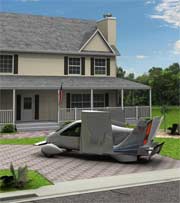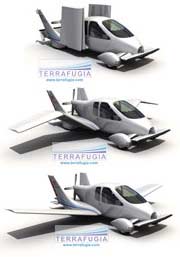It’s named the Transition, and the first full-scale model is taking shape inside a former machine shop on an industrial back alley in Woburn, MA. Between now and late July, the 10 employees of angel-funded startup Terrafugia will be spending “a lot of long days, nights, and weekends” in that shop, says CEO and founder Carl Dietrich. That’s because they want to show off their concept vehicle at AirVenture—the world’s largest aviation festival, held annually in Oshkosh, WI—and there’s a lot of work to finish first.
Technicians are shaping the grooves in the fuselage’s carbon-fiber skin that will hold the straps for the vehicle’s rocket-fired emergency parachute. They hadn’t yet attached the folding wings to the fuselage or the fuselage to the empanage (which will hold up the dual tails), and they had yet to figure out where to put the engine’s exhaust system. “It’s crunch time,” says Dietrich.
And the work won’t end after Oshkosh. Terrafugia wants to deliver the first Transition to a customer by the end of 2009 and go into large-scale production by 2012. If you were just building a new type of plane or a new type of car, that schedule would be ambitious enough. But the Transition is both—and if, as the company intends, pilots are to land the vehicle on an airport runway, fold up the wings, and tool right out onto public highways, then this hybrid-of-a-different-color will have to meet federal standards for both aviation safety and highway safety.
Which means going through the demanding certification processes set up by the Federal Aviation Administration and the National Highway Traffic Safety Administration. Then there are problems like building fail-safe folding wings that can be verifiably locked into flying position; making the vehicle light enough not only to fly, but to qualify as a Special Light-Sport Aircraft (of which more below); working with insurance companies to create a new kind of policy combining the accident insurance required for automobiles with the hull and liability insurance required for airplanes; and finding new investors with the stomach for the kinds of risks Terrafugia is taking.
In other words, there are a thousand practical obstacles to achieving the flying-car dreams Deitrich says he’s had since he decided to become an aerospace engineer at the age of 8—-to say nothing of actually making a bit of money along the way. “The old joke is that the best way to make a small fortune in aviation is to start with a large one,” says Dietrich. But while he admits that building a plane that you can also drive “sounds off the wall,” he says “there is a real business case for investing in its success. I’m personally invested, as are a lot of the people here. I don’t see any way we’re not going to get this done.”
Terrafugia CEO Carl DietrichThere’s plenty of reason to take Dietrich seriously. The 30-year-old earned his bachelor’s, master’s, and doctoral degrees in aeronautics and astronautics from MIT, and was awarded the $30,000 Lemelson-MIT Student Prize in 2006 in recognition of his groundbreaking designs, including a desktop-sized fusion reactor, a pumpless rocket engine, and a blast-safe pick for removing land mines. Dietrich put the prize money into Terrafugia, which he co-founded with fellow MIT aero-astro grads Samuel Schweighart and Anna Mracek (now his wife) and two former MBA students from MIT’s Sloan School. Their plan to manufacture a road-ready airplane was the runner-up in the business venture category of the 2006 MIT $100K Entrepreneurship Competition—winning the company a $10,000 check that still hangs on the wall of Terrafugia’s “prototype development facility,” a modest space formerly used to manufacture garage doors.

